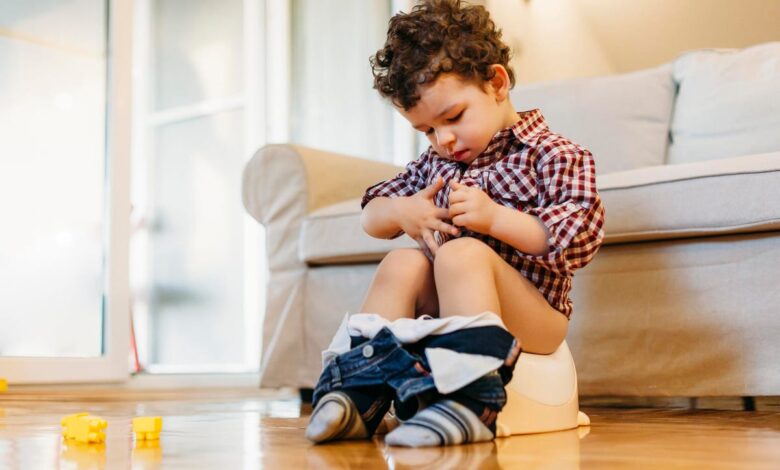Trouble Potty Training? There Might Be A Therapy That Can Help

Little baby boy is sitting on potty
Deborah Perez is a mom to triplets, two of whom were easily potty trained.
“The third tried and tried, but just couldn’t,” Perez recently said. “He would ask to try every 10 minutes. He would sit there for over 30 minutes. We couldn’t find Pull-Ups to fit him anymore. He was embarrassed to go anywhere because of the Pull-Ups or fear of accidents. Family outings were a nightmare with having to stop at a bathroom so often to try.”
And so it went, through months and months of potty-training attempts and fails.
Research tells us that parents are taking their time with potty training these days, starting the process months later than they have in decades past. But even with the delayed start, most healthy, neurotypical kids achieve at least daytime continence by age three.
When that doesn’t happen, there can be a variety of factors at play. Including, according to one occupational therapist, overly weak or overly tight pelvic floor muscles.
Introducing Pelvic Floor Therapy
Beth Kohler-Rausch is an occupational therapist at Northwestern Medicine Central DuPage Hospital. One of her specialties is pediatric pelvic floor rehabilitation.
“Pelvic floor therapy addresses bladder and/or bowel dysfunction,” Kohler-Rausch explained. “Treatment can be very individualized based on the child and there may be more than one factor, from musculoskeletal or orthopedic concerns, neurological, sensory considerations, coordination deficits, or behavioral issues.”
When treating a child who is struggling with using the toilet, Kohler-Rausch said the treatment may include:
- Biofeedback
- Stretching
- Muscle strengthening
- Breathing strategies and exercises
- Soft tissue and/or joint mobilization
- Manual techniques such as massage
- Electrical stimulation
- Sensory supports
- Educational instruction on toilet routine
“I really like to look at pelvic rehab not only as addressing a physical condition, but also lifestyle factors and promoting independence with toilet routines,” Kohler-Rausch said.
Who Needs Pelvic Floor Therapy?
By the time most kids are referred to a physical or occupational therapist for pelvic floor therapy, Kohler-Rausch said they’ve usually also seen a urologist or a GI doctor to rule out other potential problems.
“Children can be referred for a number of reasons such as night time wetting, urinary or fecal incontinence during the day, history of frequent UTIs, difficulty with potty training, overactive bladder or urgency,” Kohler-Rausch explained. “Other children may have a more formal diagnosis such as Hirschsprung’s disease, slow transit constipation, or pelvic floor dyssynergia to name a few.”
For most kids, she said, this type of therapy doesn’t begin until the child is at least four years of age. “But there are reasons why a younger child may need to be referred,” she said. “It just depends.”
In Perez’s case, by the time she brought her son to pelvic floor therapy, she felt like they had tried everything else. “We were already in occupational therapy for some sensory issues and the therapists suggested pelvic therapy to us based on his symptoms.”
And so, treatment began.
How Can Pelvic Floor Therapy Help?
Most parents of healthy, neurotypical children take it as a given that their child will be able to potty train when the time is right. Unfortunately, that isn’t always the case.
“Factors such as the ability to coordinate their muscles or impairments in strength of the pelvic floor may be impacting their ability to urinate or defecate,” Kohler-Rausch said. “Sensory factors such as not feeling the urge to use the toilet can also be a barrier and therapy may help.”
When a child first reports trouble potty training to their child’s pediatrician, they may be prescribed laxatives or other medications to try. But when those interventions don’t help, pelvic floor therapy may.
“If medical management alone—such as medication or even some initial behavioral supports such as timed sits on the toilet—are not producing changes, I would highly recommend a referral for pelvic floor therapy,” Kohler-Rausch said.
Not Your Mama’s Treatment
The concept of treating incontinence in a child with this type of therapy may be foreign to some parents. Especially those women who have had to seek pelvic floor therapy themselves after pelvic surgeries or giving birth. But parents can rest assured that while the treatments share the same name and focus on the same muscles, the type of treatment children receive differs in quite a few ways from what an adult may have experienced.
“Adult therapy often includes internal work,” Kohler-Rausch said. “Most pediatric pelvic floor treatment is external.”
In other words, most children will not receive a pelvic floor massage or be asked to insert some of the instruments adults often are in these kinds of treatment settings.
“Depending on the age of the child, I personally try to bring in their interests and find ways to normalize the conversation around bowel and bladder habits. I often incorporate games and other child friendly activities as appropriate.” Kohler-Rausch said.
Still, practice at home is essential to success. “If a child is not motivated to work on their home program between visits, than the sessions with me will not make any difference.”
How Successful Is Treatment?
Perez and her family went into pelvic floor therapy skeptical.
“I had never heard of it before so I had some questions,” she said. I also had doubts simply because we had tried so many things and failed. We felt everything was hopeless at that point.”
The good news is, with a motivated family and child, Kohler-Rausch said pelvic floor therapy can be very successful.
But it’s not necessarily a quick fix.
“Some children may need to be followed up to a year in some capacity, especially for bowel dysfunction and if there are multiple factors going on such as urinary and fecal incontinence,” Kohler-Rausch said.
There are things parents can do to improve the chances of success, to include following the home program the therapist assigns and encouraging kids to be motivated and active participants.
“I find providing regular diaries or logs to track progress at home to be very beneficial and help guide treatment,” Kohler-Rausch said. “Success is also dependent on any medical aspect of their condition such as medication management.”
What to Expect
Coming up with an individualized treatment plan for a child and their specific needs means that every session of pelvic floor therapy is different.
“Sessions may include exercises such as lunges or wall sits,” Kohler-Rausch said. “For children who are nervous or embarrassed about this topic, we play games or do crafts that bring in the conversation of toileting or our bodies.”
With Perez’s son, sessions started off with coloring and games.
“I couldn’t see the connection,” she said. “Then it moved to exercising and stretching, which still did not make sense to me. But then we started to see small changes in his attitude and behavior about using the bathroom and it started to make sense.”
Kohler-Rausch likes to start off with teaching kids about the different parts of their urinary and digestive tracks, to include where their pelvic floor is and what it does.
“I often use biofeedback with children to help them understand how to control their pelvic floor,” she explained. “This could involve animated biofeedback which involves small sensors placed on their bottom or pelvic floor muscle which is contacted to a computer with graphics that respond to the muscle contracting or relaxing.”
Other times, she may have them place their hands on their muscles so that they can feel them contracting and relaxing.
“We may use other methods of feedback such as using a mirror and they can see what their bottom does when they squeeze their muscles tight or when they bear down like they have to poop,” Kohler-Rausch said. “I incorporate breathing activities and exercises because our diaphragm and pelvic floor must work together in a coordinated fashion.”
She said it’s also not always about the pelvic floor alone. Sometimes her work with children focuses on how the surrounding muscles help support the pelvic floor, and how everything works together in a coordinated fashion.
“As an OT, I often see children who not only have pelvic health concerns, but may also need sensory supports to help them attend and relax while using the toilet. Parent education and education around toilet routines and habits is a large part of treatment,” she explained.
For Perez’s son, the family started noticing a difference in his toilet training behaviors just a few months after treatment began. By 10 months, “He was 100% potty trained for urine and bowel movements and was dismissed by his therapist.”
Taking That Step
Kohler-Rausch warns that it can sometimes be difficult to find therapists trained in this specialty.
“Your medical providers such as pediatricians, urologists, and gastroenterologists are great places to start,” she suggested. “When calling a therapy clinic directly, it is always best to ask if they have a therapist with pelvic rehab training.”
When you can find someone who can help, she explained, the effort is worth the outcome.
Perez agreed, adding that parents should never stop advocating for their children.
“Everyone’s needs are different, everyone learns different. Two kids could have the same issue and symptoms but not need the same cure,” Perez said. “Therapy is not a one size fits all packaged box.”
When she and her family were left with a lack of resources and support, pelvic floor therapy felt like the last resort.
“Had we not tried a therapy we had never heard of, where would we be today?”




